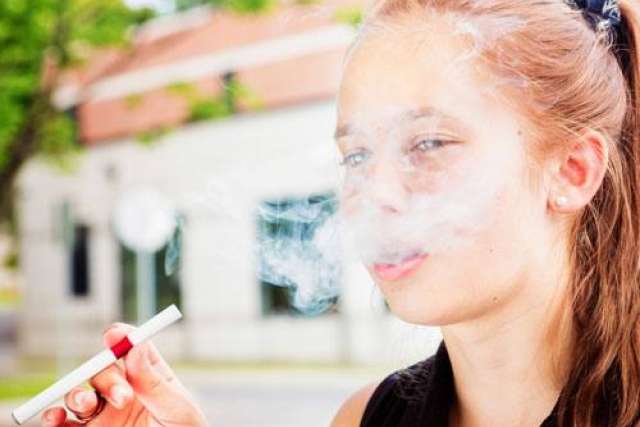In 2003 the e-cigarette (e-cigs or vape) was invented. E-cigs use a lithium battery (or another power source) to heat a liquid that contains flavors and nicotine. The heat creates a cloud of vapor that looks like smoke, which the user inhales from the mouthpiece.
Use of e-cigarettes is a gateway to tobacco use
Studies show the use of e-cigarettes in preteens and teens increases the likelihood that they will use tobacco products later on. Tobacco products have many known health risks, including cancer.
Tobacco cigarettes kill about 50 percent of people who use them. To stay in business, big tobacco companies need to build a pipeline of users. E-cigarettes market to young people by offering candy and dessert flavors.
According to one tobacco executive: “The base of our business is the high school student. The fragile self-image of the young person needs all the support it can get. Smoking may appear to enhance that self-image.”
Health risks of vaping
There are known health risks associated with vaping in adolescence. While vaping doesn’t burn anything or create tar in the lungs like tobacco products do, it does deliver nicotine, which:
- Increases heart rate and blood pressure
- Has powerful effects on the brain — it releases neurotransmitters like dopamine, which reward the body and make you want more
- Is a stimulant, making you feel more alert (and craving more when the stimulant wears off)
- Impairs the body’s natural ability to produce dopamine — you’ll soon need nicotine to feel normal
- Has addictive properties comparable to heroin and cocaine, and an immature brain is more vulnerable to addiction
E-cigs also contain chemical solvents which transform into formaldehyde (which is known to cause cancer) when heated. Other chemicals used to generate the 7,000+ flavors may be toxic to living cells or potentially cancer-causing.
Signs your child may be using e-cigs
You might be unaware your child is using e-cigarettes. It can be difficult to catch your child in the act of vaping and the vapor leaves no smell or residue. Concerned parents should watch for these signs:
- Dry mouth: Vaping leaves users with a dry mouth and palate. Your child may be thirstier. He or she may also reach for saltier or more flavorful foods because a dry mouth dulls the ability to perceive flavor.
- Nosebleeds: The nasal passages also dry out. Nosebleeds can result from this dryness.
- Acne: Vaping can irritate the skin. If the skin around your child’s mouth is breaking out, but the rest of the skin is clear, they may be vaping.
- Lung concerns: Additives in e-juice may cause inflammation of the lungs. The inflammation can lead to a bacterial infection or pneumonia.
- Unidentifiable spare “parts”: Some e-cigs have parts that need to be exchanged or replaced. If your teen has some object that seems out of place, it may be used for vaping.
Talk to your child’s health care provider if you are concerned about vaping. Find a general UCLA Health pediatrics provider or make an appointment by calling 310-825-0867. To meet the needs of youth and young adults age 12 to 25, UCLA Health offers Adolescent and Young Adult Medicine services from specially trained doctors.



